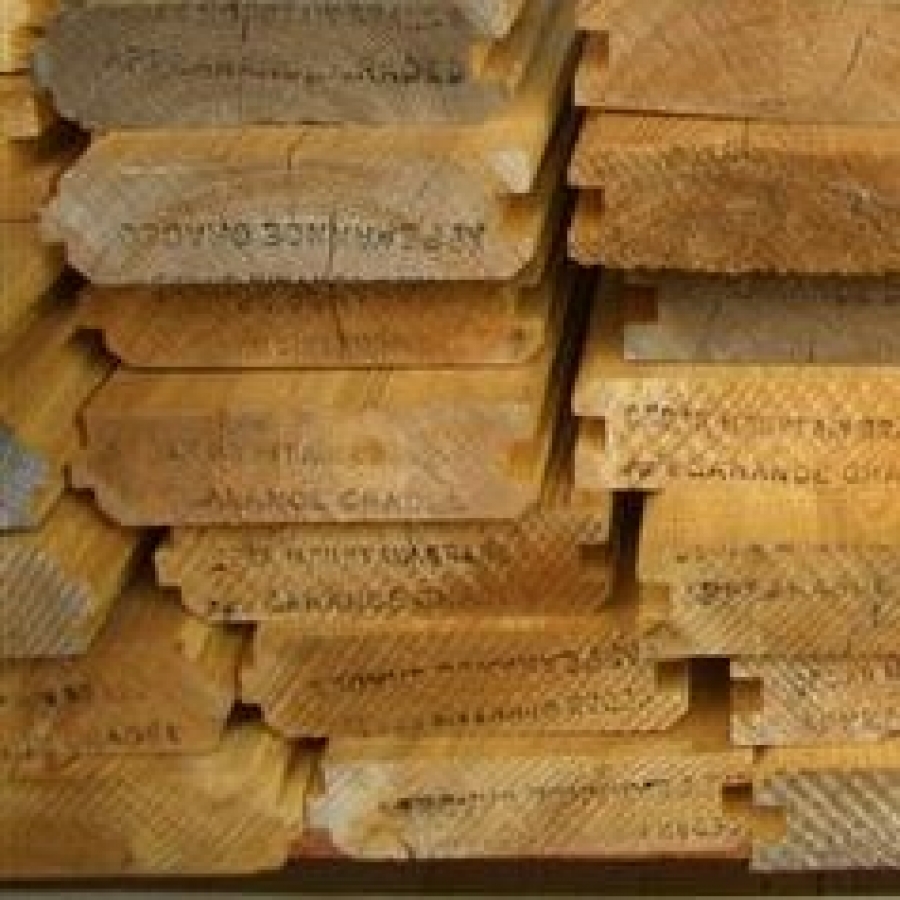Wood Decking
Wood decking is created using structural boards or planks and attaching them to joists, beams, rafters, or trusses to form a floor or roof surface. Similar to sheathing, the boards act to provide lateral support to the structure and carry the live and dead loads from above to the floor or roof structure below.

Topic Summary
Wood planks were used exclusively in the floor and roof assemblies of structures until the 1950s, when plywood sheathing became available. In houses built during the earlier part of the 20th century, planks were installed and finished as the finish floor surface, or planks were installed as a subfloor under a finish wood floor surface, depending on what the owner could afford. Wood plank construction during this time consisted of two type of planks, straight edged and tongue and grooved edged planks. Most common were the straight edged planks which were butt jointed together and installed perpendicular to the structure, or on an angle, with intermittent blocking to support the planks' edges. Tongue and groove planks were reserved for use under resilient flooring. The use of wood planks in floor and roof assemblies continued into the 1970s, although newer structures primarily use wood sheathing. Today, wood decking is used under some roofing material, and on ceilings, decks, patios, docks, boardwalks and bridges.
Roofs installed today that utilize wood decking are primarily limited to wood shake and shingle roofs. Wood shake and shingles are installed over softwood decking that is typically 1x4 or 1x6. The boards are butt jointed together near the eave, then spaced apart up the roof. Wood decking may be directly fastened to the top of the roof structure (rafters or trusses) or installed over furring strips attached to sheathing to provide additional ventilation within a roof structure.
In some cases an exposed natural wood is desired as an interior ceiling finish. To achieve this, the wood decking is installed flat or on edge under the sheathing and along the top of the roof structure, or it is attached to the underside of the roof structure. Wood decking laid flat is either tongue and groove material or manufactured laminated lumber. Wood decking laid on edge is fastened together with nails and creates a single laminated unit. Wood decking for this application typically has three thicknesses: 1 1/2 inches, 2 1/2 inches and 3 1/2 inches. The edge detail on tongue and groove decking may be V-groove, eased, squared, beaded or custom milled.
Wood bridges, intended for light traffic, also utilize wood decking. The wood decking is laid flat and attached to stringers. Wood material may be seasoned or unseasoned. Unseasoned wood is commonly installed butt jointed to together to allow a gap between planks after shrinkage occurs. Seasoned wood is installed with a gap between planks to allow swelling to occur.
The most common use for wood decking occurs on our outdoor walking surfaces. It is the aesthetic finish material on decks, patios, boardwalks and docks. Wood commonly used in these applications includes: pressure treated Southern Yellow Pine, Cedar, Redwood, Larch, Cypress and Mahogany. Stock sizes of wood decking include 5/4x4, 2x4, 5/4x6, and 2x6, in lengths up to 16 feet. Pressure treated Southern Yellow Pine is the least expensive option for wood decking, and typically lasts for 15 years. Cedar and Redwood offer a natural defense against insects and decay; however, they are known to fade to gray in the sun. They will typically last for 20 years.
There are also a number of exotic woods available for use as wood decking, including Ipe, Red Balau, Golden Ironwood, Cambara, Cumaru, Tigerwood, Garapa, and Tamarack. These woods are typically the most expensive option for wood decking and could last up to 25 years. Exotic woods, depending on the species, are available in a number of different sizes. Ipe, for example, can be ordered in nominal 1 inch, 5/4 inch and 2 inch thicknesses. Widths range from 2 to 12 nominal inches and lengths are available up to 16 feet.
Wood decking is typically milled with a radius edge or bull nose. Boards can be installed with stainless steel or galvanized nails or screws appropriate for the wood decking being installed. In some cases, deck spacers are desirable to ensure the recommended 1/8 inch to 1/4 inch gap between boards to allow for the passage of water and reduce wood swelling. Decking material can be installed in several different patterns. Boards are typically installed horizontally, but they can also be installed on an angle, or in a herring bone or picture frame pattern.
Critical to a long lasting and beautiful wood deck is maintenance. Regular cleaning and sealing is required. The deck should be regularly swept off and cleaned to remove debris and stains. Depending on the wood deck sealant used, sealing should occur every two to three years.

Buildipedia Staff
The Buildipedia research and writing staff consists of dozens of experienced professionals from many sectors of the industry, including architects, designers, contractors, and engineers.
Website: buildipedia.com/


